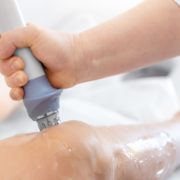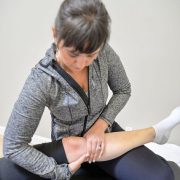Want to Avoid a Total Knee Replacement? Start Here.
Every year, around 700–800,000 Americans undergo total knee replacement surgery – and that number continues to climb.
Here in Portsmouth, NH, we see this trend too – but what if many of those surgeries weren’t actually necessary?
It’s true that knee replacements have an excellent success rate, with more than 90% lasting 20 years or more. But here’s something most people don’t realize…
Only 15% of people who show signs of osteoarthritis on X-ray actually have symptoms. That means the majority of folks walking around with “bone-on-bone” arthritis don’t have any pain at all. Meaning, “severe arthritis” showing up on an X-ray isn’t the be-all-end-all diagnosis you thought it was.
So why do so many end up under the knife?
Because structural findings on imaging – like arthritis, bone spurs, or meniscus tears – are often blamed for pain that may actually have another cause. If you want to avoid knee replacement surgery, it’s critical to understand what’s really behind your pain and whether you’ve exhausted all your options first.
Here are three key things to look at before you resign yourself to surgery.
1. Don’t Let an X-ray Decide for You
Too often, people are told they need a knee replacement because their X-ray “looks bad.” But your level of pain and function – not your imaging – should be what drives your decision.
If you can still walk, climb stairs, and do most of your favorite activities with manageable discomfort – why rush into major surgery with months of recovery and potential complications?
Knee replacement can be life-changing for those in severe, unrelenting pain – but if you’re still functioning relatively well, it’s worth holding off. You may find that a targeted approach to movement, strength, mechanics, and healing can relieve your pain and keep you active for years – without surgery.
And if you’ve already tried physical therapy and exercise but still feel limited, regenerative treatments like Shockwave Therapy and EMTT (Extracorporeal Magnetotransduction Therapy) can help bridge the gap. These non-invasive technologies work by stimulating tissue repair, reducing inflammation, and improving circulation – essentially helping your body heal itself. For many people with chronic knee pain or mild arthritis, regenerative therapy has been a game changer – providing relief and better mobility without needles, surgery, or downtime.
In short, before deciding your knees are “too far gone” just because an X-ray told you so – explore whether your body still has the capacity to heal. You might be surprised at how much function and comfort you can restore with the right approach.
2. Check Your Back (Yes, Really)
One of the most overlooked causes of persistent knee pain is your spine.
A study published in the Journal of Manual and Manipulative Therapy found that over 40% of people with isolated limb pain responded to treatment directed at their spine – even when they didn’t think their back was involved. Plus, even without this study, I’ve seen this all too often in real-life practice.
That means your “knee pain” could actually be coming from irritation in your lower back or nerves. If your knee pain comes and goes, varies with position, or you also experience back stiffness or leg tingling – don’t ignore it or assume it’s all in your knee.
Getting evaluated by a Portsmouth, NH mechanical pain specialist who can test whether your pain is spine-related or knee-related can save you from years of ineffective knee treatments…
3. Assess Your Mobility, Not Just Your Arthritis
If your knee is truly arthritic and severely damaged, it will usually feel stiff and restricted all the time. But if your stiffness fluctuates – maybe it loosens up after you stretch, or feels fine one day and tight the next – that’s a big clue your pain could be mechanical – not degenerative.
Sometimes, a small meniscus fold or mechanical joint restriction is the real culprit, and when the joint is moved the right way, the restriction disappears – along with your pain. Unfortunately, this won’t show up on an X-ray or MRI – and many clinicians miss it unless they’re trained in mechanical diagnosis.
Before agreeing to surgery, find out whether your joint motion can be restored naturally. When you regain full, pain-free movement, your knee may not need replacing after all.
The Bottom Line:
Knee replacements absolutely have their place. For some people, they’re the best path to relief and mobility. But far too many people jump to surgery because they were told their X-ray “looked bad” instead of being evaluated properly for the true source of their pain.
If you’re over 40, dealing with nagging knee pain, and want to avoid surgery as long as possible – start by getting your back checked, your movement analyzed, and your regenerative options explored by someone trained in mechanical pain and tissue healing.
You might just find there’s still plenty of life left in your knees – and the added bonus will be you avoiding a major surgery.
Are you local to Portsmouth, NH?
CLICK HERE to request a free discovery visit with one of our specialists in downtown Portsmouth.
Dr. Carrie Jose, Physical Therapist and Mechanical Knee Pain Expert, owns CJ Physical Therapy & Pilates in Portsmouth and writes for Seacoast Media Group. To get in touch – or reserve a seat in her upcoming Masterclass on How to End Knee Pain Naturally – CLICK HERE.










